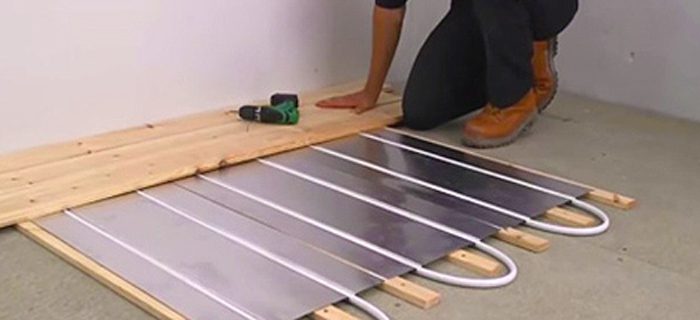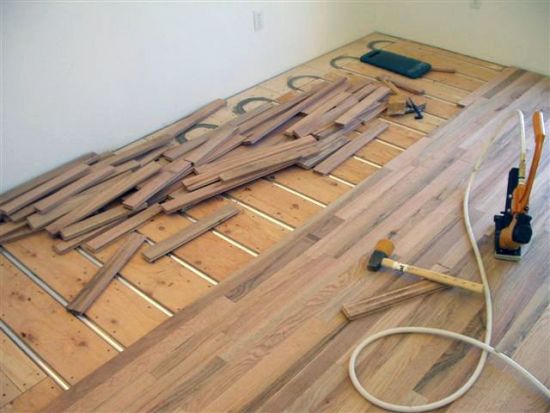
Engineered flooring can be used with any type of under-floor heating. However, if you want to install this flooring type over UFH, you must ensure that several conditions are met. Firstly, you will need to get a written confirmation from your underfloor heating supplier that the entire system works properly with controlled temperatures to ensure that the subfloor surface does not exceed 27°C. Therefore, apart from room stats, you will need flow control valves and floor temperature probes. Moreover, it is recommended to apply a few floor temperature data loggers, e.g. Fidbox – they will be proof that the floor has not overheated in the unlikely event of a warranty claim.
Checklist
Moreover, remember to check the following before installing the floor:
– The moisture content of the concrete screed should not exceed 1.8%
– The moisture content of the wood flooring should not exceed 10%
– The relative humidity of the air should range between 40% and 65%
– The maximum deviation in flatness should be less than 3mm per linear metre
– The sub-floor should be a closed and self-supporting surface
– The sub-floor should be clean, and you should remove all the dust before installation
– Ensure that, if you use plywood or chipboard as an additional sub-floor, they are of good quality.

Use experts
Furthermore, UFH needs to be installed by experts recognized by the UFH manufacturer. In this way, you will ensure that all the work are performed professionally. All hot water pipes should be sufficiently below the top surface of the screed, which will help guarantee even heat distribution and will prevent hot spots. They should be placed normally at about 35-40mm. Also, there needs to be sufficient insulation below the UFH as well as a functional DPM, which will prevent moisture from being drawn up through the screen. Do not try to force dry the screed with the use of UFH – by doing so, you can destroy the integrity of the cement screed.
Moreover, the UFH needs to be commissioned by the installer. On the first day, the pipe water temperature needs to be set to 20°C and then increased to 5°C each day to reach a maximum of 45°C, and this temperature needs to be maintained for 8 days. Then, you will need to reduce the temperature 5°C a day over 8 days. So, the total commissioning period should be 21 days. Bear in mind that during the entire commissioning period, you will need to provide good ventilation.
Your UFH installer will need to provide a certificate of the commissioning, which should encompass the records of the temperatures reached the sub-floor surface.
Prior to fitting the floor, you will need to turn off the UFH and leave it off throughout the fitting process. Once the floor is laid and finished, you shouldn’t turn off the heating for at least 48 hours. Then, as the floor has already been oiled, the oil manufacturer’s instructions should be followed. Sometimes this may require a waiting period of 2 weeks. Then, the floor temperature can be increased by 1°C or 2°C each day.
Avoid extreme temperatures
The most important thing is not to subject the engineered wood flooring to extreme temperature and humidity fluctuations in a short period after installation. In such a case, the wood flooring can get delaminated. It would be best if the UFH was never turned off completely; instead, it should be on at a low temperature. If you turn off the UFH, the flooring gets cold, as may be the case during summer then when you turn it on again, the rise of water pipe temperature needs to be controlled as described above. Furthermore, remember to keep the relative air humidity level between 40 and 65% in order to make sure that the wood doesn’t get excessively dry. To do that, you may need air humidifiers.
Avoid rapid changes in temperature
All in all, do remember to avoid rapid changes in the surface temperature. Use a sufficient amount of adhesive to avoid hot spots and uneven distribution of heat. Remember to keep room humidity at a proper level, i.e. not too high or low. The surface temperature should be over 27°C. Don’t ever clean the floor with an excessive amount of water. If you have installed UFH, do not put any thick rugs or carpets on the floor, as this can increase the wood temperature. And also, do not turn the heating on and off.
The above pieces of advice should be followed, or otherwise you may end up with gaps appearing between boards, cracks appearing on the wood surface, warped boards, delamination of the top layer or blocked heat transfer through the boards.
| Mon-Fri | 8:00AM – 5:00PM |
| Saturday | 10:00AM – 4:00PM |
| Sunday | 11:00AM – 3:00PM |





.svg)
.svg)